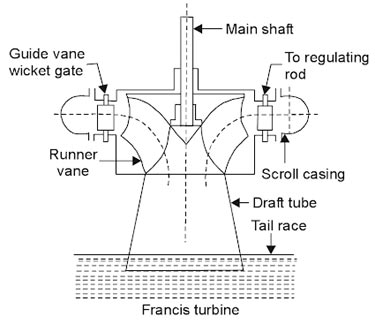Francis turbine is usually used for
Right Answer is:
Medium heads
SOLUTION
Turbines are classified as given below:
- Based on the action of water flowing through the turbine runner
- Impulse (Pelton wheel turbine)
- Reaction turbines (Francis and Kaplan turbines).
- Based on the main direction of the flow of water in the runner
- Tangential flow (Pelton wheel turbine),
- Radial flow, axial flow (Kaplan turbine)
- Mixed flow turbine (Modern Francis turbine).
- Based on the head and quantity of water
- High head and low discharge > 600 foot (Pelton wheel turbine)
- Medium head and discharge 60 to 500 foot (Modern Francis turbine)
- Low head and high discharge turbines (Kaplan turbine).
- Based on the specific speed
- Low (Pelton wheel turbine)
- Medium (Francis turbine)
- High specific speed turbines (Kaplan turbine).
- Based on the axis of disposition
- Horizontal axis
- Vertical axis turbine.
The inward flow reaction turbine having radial discharge at the outlet is known as Francis turbine, after the name of J.B. Francis an American engineer who at the beginning designed inward radial flow reaction turbine. The flow of water in the turbine may be radially from outward to inward or from inward to outward. but in both cases, the flow passing through the runner has the velocity component in a plane normal to the axis of the runner.

In modern Francis, turbine water enters the runner of the turbine in the radial direction at outlet and leaves in the axial direction at the inlet of the runner. Thus the modern Francis turbine is a mixed now type of turbine in which water enters radially at its outer periphery but leaves axially at its center.
Working of Francis Turbine
Since the modern Francis turbine is a mixed flow type, the water enters radially at the outer periphery of the runner and levee axially. These turbines operate under medium heads and require a medium quantity of water. The water first passes through guide vanes, which in turn direct the water at the proper angle so that the water enters the runner vanes without shock and glides properly. As the water passes through the runner and proceeds towards an outlet. Some part of the head acting on the turbine is transformed into a kinetic head and the rest remains pressure head. There is a difference of pressure between guide vanes and the runner is called reaction pressure. The reaction pressure is responsible for the motion of the runner. Since the pressure al inlet of the turbine is much more than the pressure at the outlet, the water in the turbine must flow in a closed conduit and the runner should always be full of water. After passing through the runner the seater is discharged to tailrace through a draft tube of suitable shape and size.
